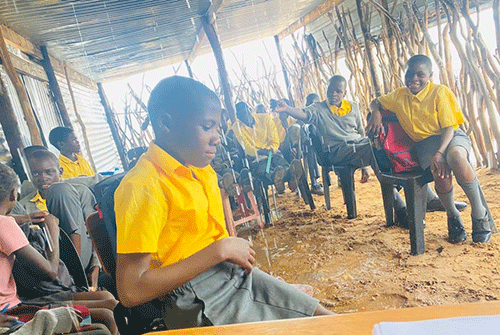ONGWEDIVA – The heavy rains which have showered most parts of the country have promised good harvests to many, but pupils at the Twapandula Primary School in the Oshikoto region find the downpours unfortunately synonymous with misery and distress.
Ironically, Twapandula loosely translates to “we are thankful” in Oshiwambo, but that certainly doesn’t speak to the reality for these pupils.
The constant heavy showers of the last few days present a nightmare not only as it soaks the children on their long way to and from school, it also does not spare them in their makeshift classrooms constructed only of poles and zinc. With feet submerged in mud while the rain pours on them through a leaking roof, these learners have no option but to acquire education under the harsh conditions.
Speaking to New Era, school principal Hilya Uugulu said their plight worsens during rainy seasons as they do not have proper structures to protect learners and teachers from the elements.
“When it rains, they will all rush and squeeze themselves in a corner of the classroom to shield themselves from the cold as the water flows right by their feet. As the temperature rises on sunny days, the heat becomes unbearable, and when it is windy, the wind blows sand onto them. It is so painful to watch,” the principal lamented.
The rudimentary structures were constructed by enterprising parents who had no choice but to try and ensure that their children are taught and acquire knowledge, despite their challenging circumstances.
“It has been going on for as long as I can remember. However, this year, we have received strong rainfall and the sheds have also gotten old. These structures can no longer stand heavy rains, and the classrooms became flooded,” Uugulu stated.
She said during the last few days, the learners affected are being taught “in a pool of water”.
Uugulu noted that a significant number of learners miss out on classes due to the virtually non-existent infrastructure, and this ultimately leads to poor educational outcomes. These factors also strain learners’ ability to learn and receive a quality education.
The school is situated on the northeast side of King Kauluma road in the Nehale Lyampingana constituency.
It was established in 2015, started as a kindergarten, and was then upgraded to a primary school as the population of children in the area increased.
It is now home to 277 learners from grade 0 to seven, as well as eight staff members.
It has generally been faced with challenges of poor to no infrastructure, no suitable furniture, lack of accommodation for staff members, and no running water or electricity.
“We don’t have permanent structures. We only have one main block of four classrooms and a storeroom, and another small block for pre-primary,” explained the principal.
Due to inadequate infrastructure, grades six and seven are taught in sheds. These two classrooms of over 20 learners also do not have any tables, and learners are forced to share chairs.
“Since we do not have enough furniture, we tried to provide the young ones with the remaining furniture while the upper-primary cohort does most of their school work on their laps,” she noted.
The school predominantly caters for children whose parents are employed as workers on nearby farms.
“The children already have difficulties at home. Most of them are from impoverished backgrounds. They walk long distances to school. I have observed that these children are eager to learn. Through hail, heavy rains and unbearable weather conditions, most of these children will always make it to class, and it is so painful to watch them enduring such harsh conditions,” continued the principal.
The teachers are also not spared from the elements, and are likewise forced to work in an unconducive environment.
Help has been elusive for the besieged school.
“I am not sure if the regional directorate is aware of our situation, but so many times we requested assistance through the circuit office. The former inspector was aware of it, but we have not received help hitherto,” she stated.
The situation at Twapandula is not unique as it portrays the array of challenges faced not only by public schools in the Oshikoto region, but countrywide.
Constituency councillor Joseph Shikongo is aware of the situation, and said it is emblematic of the problems with many schools in his area.
“It is not uncommon. When the population of the schools becomes high and the schools cannot accommodate all learners in the available classes, they resort to makeshift classrooms. Unfortunately, the rain pours on our learners while they are in the classrooms. These children are our future, and they need our support,” he stressed.
Uugulu appealed to good Samaritans in the country to assist the school either monetarily or in kind.
“We are seeking all kinds of donations, either building materials or furniture to upgrade our school. We also do not have a library at school and need reading materials for the learners,” the principal pleaded.
Approached for comment on Friday, education director in the region Aletta Eises promised to revert. At the time of going to print, she had not.
New Era further understands that after a video of the affected learners went viral on social media on Thursday, some education officers in the region rushed to the school to assess the situation.
Questions sent to the ministry of education’s executive director, Sanet Steenkamp, went unanswered at the time of going to press.
Meanwhile, President Hage Geingob last week called for the urgent acceleration of plans to construct classrooms by using August 26, a defence force company, to do the work.
– ashikololo@nepc.com.na


